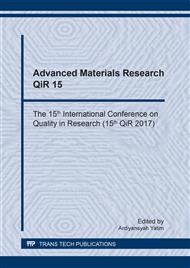p.50
p.56
p.63
p.70
p.78
p.86
p.93
p.103
p.109
The Influence of Nano Filler on Thermal and Mechanical Properties of Polypropylene
Abstract:
In order to obtain specific properties in the commercial and engineering applications, PP materials are often combined with additives. Filler is one of solid additive type that made of inorganic materials and is generally distinguished by its influence on the mechanical properties of the resulting mixture with the plastic matrix. Filler dimension less than 100 nm is often categorized as a nanofiller and added to plastics with the range of percentage from 1% up to 10%. Various studies have been conducted to know the influence of filler on mechanical properties, but this study is also conducted to investigate the effect of nanofillers on thermal properties of PP material. Thermal properties are very important to know from the stage of design, processing until the end use final product. Most plastic products are made in soft or liquid condition, the melting temperature (melting temperature, Tm) becomes the basis of the processing parameter adjustment. Investigations done by comparing the thermal properties of commercial copolymer PP material (virgin material and injection molding specimen) and PP materials containing nanofiller (virgin material and injection molding specimen) by using Differential Scanning Calorimetry (DSC), while data of mechanical properties was obtained by the tensile test. Both 1st heating and 2nd heating DSC Experiment showed that nanofilled PP need the highest endothermic effect (2.63 W/g and 1.79 W/g), but nanofiller gave no effect on melting temperature to all type of specimens (in the range of 164.3 – 166.3 °C). The elastic modulus of nanofilled PP was around 1486 Mpa, higher than non-filled PP (999 Mpa).
Info:
Periodical:
Pages:
78-85
Citation:
Online since:
August 2018
Authors:
Keywords:
Price:
Сopyright:
© 2018 Trans Tech Publications Ltd. All Rights Reserved
Share:
Citation:


